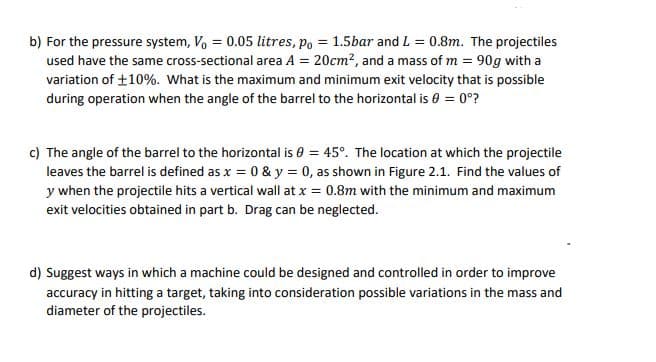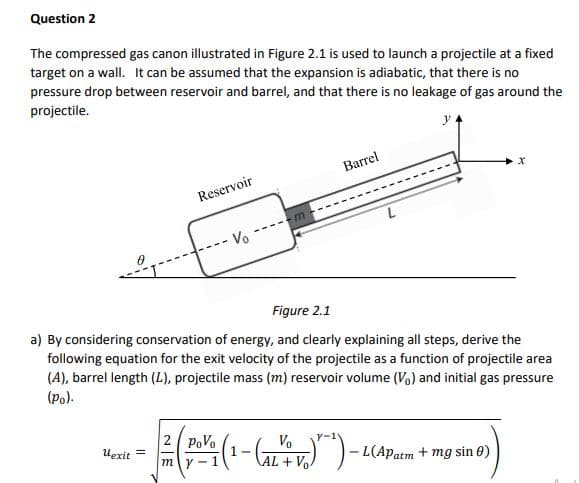The compressed gas canon illustrated in Figure 2.1 is used to launch a projectile at a fixed target on a wall. It can be assumed that the expansion is adiabatic, that there is no pressure drop between reservoir and barrel, and that there is no leakage of gas around the projectile. y Barrel Reservoir Vo Figure 2.1 a) By considering conservation of energy, and clearly explaining all steps, derive the following equation for the exit velocity of the projectile as a function of projectile area (A), barrel length (L), projectile mass (m) reservoir volume (Vo) and initial gas pressure (Po). 2 PoVo E (1-GAv)")- L(APatm + mg sin e) Vo AL + Vo Uexit = my -
The compressed gas canon illustrated in Figure 2.1 is used to launch a projectile at a fixed target on a wall. It can be assumed that the expansion is adiabatic, that there is no pressure drop between reservoir and barrel, and that there is no leakage of gas around the projectile. y Barrel Reservoir Vo Figure 2.1 a) By considering conservation of energy, and clearly explaining all steps, derive the following equation for the exit velocity of the projectile as a function of projectile area (A), barrel length (L), projectile mass (m) reservoir volume (Vo) and initial gas pressure (Po). 2 PoVo E (1-GAv)")- L(APatm + mg sin e) Vo AL + Vo Uexit = my -
Classical Dynamics of Particles and Systems
5th Edition
ISBN:9780534408961
Author:Stephen T. Thornton, Jerry B. Marion
Publisher:Stephen T. Thornton, Jerry B. Marion
Chapter9: Dynamics Of A System Of Particles
Section: Chapter Questions
Problem 9.56P
Related questions
Question

Transcribed Image Text:b) For the pressure system, V, = 0.05 litres, po = 1.5bar and L = 0.8m. The projectiles
used have the same cross-sectional area A = 20cm?, and a mass of m = 90g with a
variation of +10%. What is the maximum and minimum exit velocity that is possible
during operation when the angle of the barrel to the horizontal is 0 = 0°?
c) The angle of the barrel to the horizontal is 0 = 45°. The location at which the projectile
leaves the barrel is defined as x = 0 & y = 0, as shown in Figure 2.1. Find the values of
y when the projectile hits a vertical wall at x = 0.8m with the minimum and maximum
exit velocities obtained in part b. Drag can be neglected.
d) Suggest ways in which a machine could be designed and controlled in order to improve
accuracy in hitting a target, taking into consideration possible variations in the mass and
diameter of the projectiles.

Transcribed Image Text:Question 2
The compressed gas canon illustrated in Figure 2.1 is used to launch a projectile at a fixed
target on a wall. It can be assumed that the expansion is adiabatic, that there is no
pressure drop between reservoir and barrel, and that there is no leakage of gas around the
projectile.
Barrel
Reservoir
- Vo
Figure 2.1
a) By considering conservation of energy, and clearly explaining all steps, derive the
following equation for the exit velocity of the projectile as a function of projectile area
(A), barrel length (L), projectile mass (m) reservoir volume (Vo) and initial gas pressure
(po).
2 PoVo
Uexit =
Vo
1 -
AL + Vo
L(Apatm + mg sin 0)
my -1
Expert Solution
This question has been solved!
Explore an expertly crafted, step-by-step solution for a thorough understanding of key concepts.
Step by step
Solved in 3 steps with 3 images

Knowledge Booster
Learn more about
Need a deep-dive on the concept behind this application? Look no further. Learn more about this topic, physics and related others by exploring similar questions and additional content below.Recommended textbooks for you

Classical Dynamics of Particles and Systems
Physics
ISBN:
9780534408961
Author:
Stephen T. Thornton, Jerry B. Marion
Publisher:
Cengage Learning

University Physics Volume 1
Physics
ISBN:
9781938168277
Author:
William Moebs, Samuel J. Ling, Jeff Sanny
Publisher:
OpenStax - Rice University

Classical Dynamics of Particles and Systems
Physics
ISBN:
9780534408961
Author:
Stephen T. Thornton, Jerry B. Marion
Publisher:
Cengage Learning

University Physics Volume 1
Physics
ISBN:
9781938168277
Author:
William Moebs, Samuel J. Ling, Jeff Sanny
Publisher:
OpenStax - Rice University